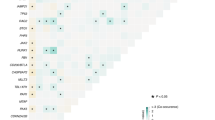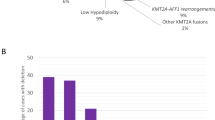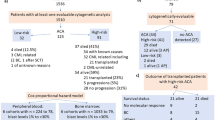Abstract
Chromosome aberrations have a major role in pediatric acute lymphoblastic leukemia (ALL) risk assignment. The Children's Cancer Group (CCG) and the Pediatric Oncology Group (POG) independently assessed the significance of trisomy for chromosomes 4, 10, and 17 in National Cancer Institute (NCI) Standard- and High-Risk ALL. Data from 1582 (CCG) and 3902 (POG) patients were analyzed. Eight-year event-free survivals (EFS) of 91% (CCG) and 89% (POG) (P<0.001) were achieved in patients assigned to NCI Standard Risk whose leukemic cells had simultaneous trisomies 4, 10, and 17. Both groups showed the degree of favorable prognostic importance increased with the actual number of favorable trisomies. POG analyses also demonstrated hyperdiploidy (⩾53 chromosomes) was less of an independently significant prognostic factor in the absence of these key trisomies. This finding supported conclusions from previous CCG and POG studies that specific trisomies are more important than chromosome number in predicting outcome in pediatric B-precursor ALL. In NCI Higher Risk patients, the number of favorable trisomies was not prognostically significant, but showed the same trend. Moreover, specific trisomies 4, 10, and 17 remain associated with favorable prognosis in Standard-Risk B-precursor ALL, even in the context of very different treatment approaches between the groups.
This is a preview of subscription content, access via your institution
Access options
Subscribe to this journal
Receive 12 print issues and online access
$259.00 per year
only $21.58 per issue
Buy this article
- Purchase on Springer Link
- Instant access to full article PDF
Prices may be subject to local taxes which are calculated during checkout


Similar content being viewed by others
References
Mastrangelo R, Poplack D, Bleyer A, Ricard R, Sather H, D'Angio G . Report and recommendations of the Rome workshop concerning poor-prognosis acute lymphoblastic leukemia in children: biological bases for staging, stratification, and treatment. Med Pediatr Oncol 1986; 14: 191–194.
Smith M, Arthur D, Camitta B, Carroll AJ, Crist W, Gaynon P et al. Uniform approach to risk classification and treatment assignment for children with acute lymphoblastic leukemia. J Clin Oncol 1996; 14: 18–24.
Donadieu J, Auclerc MF, Baruchel A, Leblanc T, Landman-Parker J, Perel Y et al. Critical study of prognostic factors in childhood acute lymphoblastic leukaemia: differences in outcome are poorly explained by the most significant prognostic variables. Fralle group. French Acute Lymphoblastic Leukemia study group. Br J Haematol 1998; 102: 729–739.
Fletcher JA, Kimball VM, Lynch E, Donnelly M, Pavelka K, Gelber RD et al. Prognostic implications of cytogenetic studies in an intensively treated group of children with acute lymphoblastic leukemia. Blood 1989; 74: 2130–2135.
Ribeiro RC, Pui C-H . Prognostic factors in childhood acute lymphoblastic leukemia. Hematolo Pathol 1993; 7: 121–142.
Heerema NA, Sather HN, Sensel MG, Zhang T, Hutchinson RJ, Nachman JB et al. Prognostic impact of trisomies of chromosomes 10, 17, and 5 among children with acute lymphoblastic leukemia and high hyperdiploidy (> 50 chromosomes). J Clin Oncol 2000; 18: 1876–1887.
Harris MB, Shuster JJ, Carroll A, Look AT, Borowitz MJ, Crist WM et al. Trisomy of leukemic cell chromosomes 4 and 10 identifies children with B-progenitor cell acute lymphoblastic leukemia with a very low risk of treatment failure: a Pediatric Oncology Group study. Blood 1992; 79: 3316–3324.
Moorman AV, Richards SM, Martineau M, Cheung KL, Robinson HM, Jalali GR, et al., for the United Kingdom Medical Research Council's Childhood Leukaemia Working Party. Outcome heterogeneity in childhood high-hyperdiploid acute lymphoblastic leukemia. Blood 2003; 102: 2756–2762.
Secker-Walker LM, Lawler SD, Hardisty RM . Prognostic implications of chromosomal findings in acute lymphoblastic leukaemia at diagnosis. BMJ 1978; 2: 1529–1530.
Williams DL, Tsiatis A, Brodeur GM, Look AT, Melvin SL, Bowman WP et al. Prognostic importance of chromosome number in 136 untreated children with acute lymphoblastic leukemia. Blood 1982; 60: 864–871.
Heerema NA, Palmer CG, Baehner RL . Karyotypic and clinical findings in a consecutive series of children with acute lymphocytic leukemia. Cancer Genet Cytogenet 1985; 17: 165–179.
Pui C-H, Crist WM, Look AT . Biology and clinical significance of cytogenetic abnormalities in childhood acute lymphoblastic leukemia. Blood 1990; 76: 1449–1463.
Dastugue N, Robert A, Payen C, Clment D, Kessous A, Demur C et al. Prognostic significance of karyotype in a twelve-year follow-up in childhood acute lymphoblastic leukemia. Cancer Genet Cytogenet 1992; 64: 49–55.
Raimondi SC, Roberson PK, Pui C-H, Behm FG, Rivera GK . Hyperdiploid (47–50) acute lymphoblastic leukemia in children. Blood 1992; 79: 3245–3252.
Trueworthy R, Shuster J, Look T, Crist W, Borowitz M, Carroll A et al. Ploidy of lymphoblasts is the strongest predictor of treatment outcome in B-progenitor cell acute lymphoblastic leukemia of childhood: a Pediatric Oncology Group study. J Clin Oncol 1992; 10: 606–613.
Groupe Francais de Cytogenetique Hematologique. Collaborative study of karyotypes in childhood acute lymphoblastic leukemias. Leukemia 1993; 7: 10–19.
Chessels JM, Swansbury GJ, Reeves B, Bailey CC, Richards SM . Cytogenetics and prognosis in childhood lymphoblastic leukaemia: results of MRC UKALL X. Medical Research Council Working Party in Childhood Leukaemia. Br J Haematol 1997; 99: 93–100.
Perkins D, Brennan S, Carstairs K, Bailey D, Pantalony D, Poon A et al. Regional cancer cytogenetics: a report on 1143 diagnostic cases. Cancer Genet Cytogenet 1997; 96: 64–80.
Raimondi SC, Pui C-H, Hancock ML, Behm FG, Filatov L, Rivera GK . Heterogeneity of hyperdiploid (51–67) childhood acute lymphoblastic leukemia. Leukemia 1996; 10: 213–224.
Olah E, Balogh E, Kajtar P, Pajor L, Jakab Z, Kiss C . Diagnostic and prognostic significance of chromosome abnormalities in childhood acute lymphoblastic leukemia. Ann NY Acad Sci 1997; 824: 8–27.
Larramendy ML, Huhta T, Heinonen K, Vettenranta K, Mahlamäki E, Riikonen P, Saarinen-Pihkala UM et al. DNA copy number changes in childhood acute lymphoblastic leukemia. Haematologica 1998; 83: 890–895.
Pui C-H, Evans WE, Gilbert JR . Meeting report: International Childhood ALL Workshop: Memphis, TN, 3–4 December 1997. Leukemia 1998; 12: 1313–1318.
Look AT, Roberson OK, Williams DL, Rivera G, Bowman WP, Pui CH et al. Prognostic importance of blast cell DNA content in childhood acute lymphoblastic leukemia. Blood 1985; 65: 1079–1086.
Shuster JJ . Practical Handbook of Sample Size Guidelines for Clinical Trials. Boca Raton, FL: CRC Press, 1992.
Maloney KW, Shuster JJ, Murphy S, Pullen J, Camitta BA . Long-term results of treatment studies for childhood acute lymphoblastic leukemia: Pediatric Oncology Group studies from 1986–1994. Leukemia 2000; 14: 2276–2285.
Gaynon PS, Trigg ME, Heerema NA, Sensel MG, Sather HN, Hammond GD et al. Children's Cancer Group trials in childhood acute lymphoblastic leukemia: 1983–1995. Leukemia 2000; 14: 2223–2233.
Tsuchiya H, Matsuda I, Kaneko Y . Why does childhood acute lymphoblastic leukemia with hyperdiploidy show a favorable prognosis? Cancer Genet Cytogenet 1991; 50: 273–275.
Nishigashi H, Ito C, Manabe A, Kumagai M, Coustan-Smith E, Yanishevski Y et al. Prevalence and growth characteristics of malignant stem cells in B-lineage acute lymphoblastic leukemia. Blood 1997; 89: 3735–3744.
Ito C, Kumagai M, Manabe A, Coustan-Smith E, Raimondi SC, Behm FG et al. Hyperdiploid acute lymphoblastic leukemia with 51 to 65 chromosomes: a distinct biological entity with a marked propensity to undergo apoptosis. Blood 1999; 93: 315–320.
Third International Workshop on Chromosomes in Leukemia. Chromosomal abnormalities and their clinical significance in acute lymphoblastic leukemia. Cancer Res 1983; 43: 868–873.
Smets LA, Slater R, van Wering ER, van der Does-van den Berg A, Hart AA, Veerman AJ et al. DNA index and %S-phase cells determined in acute lymphoblastic leukemia of children: a report from studies ALL V, ALL VI, and ALL VII (1979–1991) of the Dutch Childhood Leukemia Study Group and The Netherlands Workgroup on Cancer Genetics and Cytogenetics. Med Pediatr Oncol 1995; 25: 437–444.
Forestier E, Gustafsson G, von Heideman A, Heim S, Hernell O, Mitelman F et al. Prognostic impact of bone marrow karyotype in childhood acute lymphoblastic leukaemia: Swedish experiences 1986–91. Acta Paediatr 1997; 86: 819–825.
Author information
Authors and Affiliations
Corresponding author
Additional information
Supplementary Information accompanies the paper on the Leukemia website (http://www.nature.com/leu).
Supplementary information
Rights and permissions
About this article
Cite this article
Sutcliffe, M., Shuster, J., Sather, H. et al. High concordance from independent studies by the Children's Cancer Group (CCG) and Pediatric Oncology Group (POG) associating favorable prognosis with combined trisomies 4, 10, and 17 in children with NCI Standard-Risk B-precursor Acute Lymphoblastic Leukemia: a Children's Oncology Group (COG) initiative. Leukemia 19, 734–740 (2005). https://doi.org/10.1038/sj.leu.2403673
Received:
Accepted:
Published:
Issue Date:
DOI: https://doi.org/10.1038/sj.leu.2403673
Keywords
This article is cited by
-
PersonALL: a genetic scoring guide for personalized risk assessment in pediatric B-cell precursor acute lymphoblastic leukemia
British Journal of Cancer (2023)
-
First case of neutropenia and thrombocytopenia in the setting of cerebral cavernous malformation 3
International Journal of Hematology (2019)



